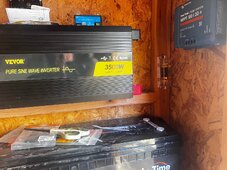Blurb time!
Well, I'll start the default answer to these questions and we can work from there. Here's you To-Do list:
1: Power audit! This will give you some important information on how big your inverter needs to be as well as how much battery capacity you'll need. There is a link in the FAQ section (I think, or someone here will post it shortly) so fill in the blanks and see what it comes up with. You'll probably need some sort of Kill-A-Watt to get accurate measurements. Are you going to be running a 12v system? 24v system? 48v system? What are the specs on your solar panels? VoC? Vmp? Being as this is a new build, throw together a wish list of what you want and estimate on the high side.
2: Where do you live? Speccing out a system for Scotland is a LOT different numbers than Arizona due to the amount of light you actually get. Someone here can post the link to the PVwatts.com or
JCR Solar Uber-Sun-Hours calculator sites to help figure out how much you'll have to work with. That will be a box in the Power Audit form.
3: Parts list: You don't need a make & model list, just a parts list to start from for reference. You'll need an inverter, a MPPT charge controller, fuses, shunt, buck converter, batteries, wire, etc. Once you have a basic list it can be fine tuned to make & models after that. If you're looking at the All-In-Ones check for correct voltage outputs (120v or 240v Split Phase for North America, 220v Single Phase for European type areas) and make sure it has enough capacity for a little bit of growth and fudge factor.
4: Budget!: Steak is great but doesn't mean anything if your wallet says hamburger.

Figure out what you're able to spend now vs what you'll have to cheap out on now and upgrade later.
5: Tape measure! Figure out where you're going to stick all the stuff you'll need. A dozen 3000AH batteries sounds great until you're sleeping on the floor because there's no room left for a bed. Is there a compartment that can house all this stuff? Will the server rack batteries fit? Are you going to have to make space? Physics can be pretty unforgiving.
6: Pencil out what you think you need and throw it at us so we can tell you what you've missed (because we ALL miss stuff the first go-round

) and help figure out which parts and pieces you're going to want to get.
Well that's the thing about solar systems, there is no 1-Size-Fits-All answer. Your system will need to be designed to fit YOUR needs. When you design and built the system, it's not going to be the perfect system for me, or Will or 12vInstall or anyone else, but it Will be the right system for You and that's the goal.
Don't panic on the Power Audit, you'll actually be doing that a few times. When you do the first pass put in ALL the Things that you might want. AirCon? Sure. Jacuzzi? Why not. MargaritaMaster-9000? Go for it.
The second pass will be the "I Absolutely Need This To Survive" list that isn't going to have much on there.
The third pass will be the "This is what is realistic" audit that you'll use to design the rest of the system.
The Power Audit is going to tell you 3 primary things: 1: How big does your inverter need to be to power your loads? 2: How much battery bank do you need to last $N number of days with krappy weather? and 3: How much solar panel will I need to install to refill those batteries in a 4 hour day (the average usable sun hours rule-of-thumb).
Once you know what you
Want and what you
Need and what your budget can
Afford there will be somewhere in that Venn diagram where those three things meet.
After that, THEN you can start looking at parts.
Yes, it's a long drawn out process, but it's worth it in the end. Not every house has the exact same floorplan, not every vehicle is the same make & model, and not every solar system is designed the same.



